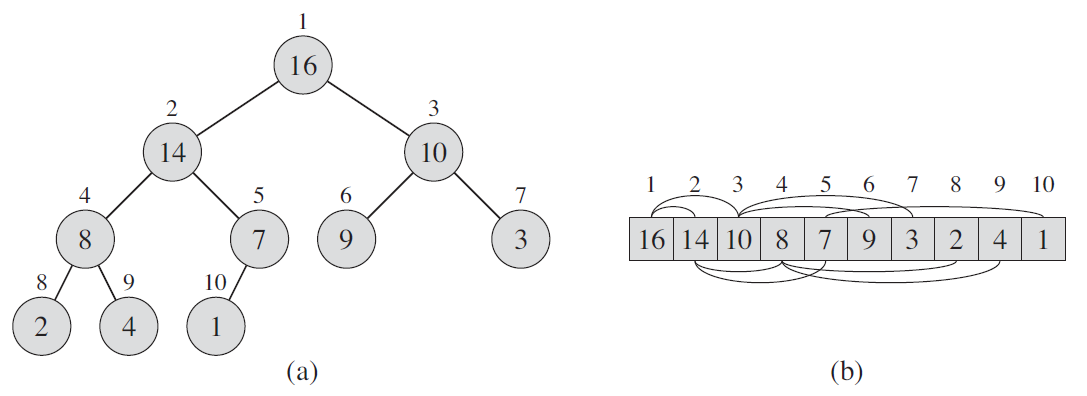
1537438215877
Use bit shift to multiply or divide
// use bitwise shift to multiply or divide by 2
// shift to the left
public void multiply(int i) {
return <<<i;
}
// shift to the right
public void divide(int i) {
return >>>i;
}def LEFT(i):
return multiply(i)
def RIGHT(i):
return multiply(i) + 1
def PARENT(i):
return divide(i)Heap Sort
def HEAPSORT(A):
BUILD_MAX_HEAP(A);
for i = A.length to 2:
A[1], A[i] = A[i], A[1]
A.heap_size = A.heap_size - 1
MAX_HEAPIFY(A, 1)The total time: \(O(n\lg{n})\)
Maintaining the heap property
- LEFT (i) and RIGHT(i) are max-heap, but A[i] might be smaller than its children
- Maintain the heap in max-heap property
def MAX_HEAPIFY(A, i):
l = LEFT(i);
r = RIGHT(i);
largest = i
# compare parent and two children
if l <= A.heap_size and A[l] > A[i]:
largest = l
if r <= A.heap_size and A[r] > A[i]:
largest = r
# if parent is not the largest, exchange with the larger children
if largest is not i:
A[i], A[largest] = A[largest], A[i]
# swap from top to bottom
MAX_HEAPIFY(A, largest)The worst case occurs when the bottom level of the tree is exactly half full
- the children's subtrees each have size at most 2n/3
\[ T(n) \le T(2n/3)+\Theta(1) \]
\[ \therefore T(n) = O(h)\ while\ h\ = \lg n \]
Building a heap
def BUILD_MAX_HEAP(A):
A.heap_size = A.length
# iterate from the first node with child
for i = PARENT(A.LENGTH) downto 1:
MAX_HEAPIFY(A, i)Analysis
The total time for BUILD_MAX_HEAPIFY:
\[ \sum ^{\lfloor \lg n\rfloor }_{h=0}\left\lceil \frac{n}{2^{h+1}}\right\rceil O( h) =O\left( n\sum ^{\lfloor \lg n\rfloor }_{h=0}\frac{h}{2^{h}}\right) \]
while
\[ \sum ^{\infty }_{h=0}\frac{h}{2^{h}} =\frac{1/2}{( 1-1/2)^{2}} =2 \]
Thus,
\[ O\left( n\sum ^{\lfloor \lg n\rfloor }_{h=0}\frac{h}{2^{h}}\right) =O\left( n\sum ^{\infty }_{h=0}\frac{h}{2^{h}}\right) =O( n) \]
Priority Queue
Priority Queue is a data structure implemented by heap.
Functions
Priority Queue supports following functions:

1537667998697
Application
- Schedule jobs (processes) in the computer. When a process is finished or interrupted, the scheduler selects the highest-priority process by calling EXTRACT_MAX.
Implementation
- We can use a heap to implement a priority queue.
- We often need to store a handle to the corresponding application object in each heap element.
- Here, the handle would typically be an array index.
def MAXIMUM (A):
return A[1]\(\Theta (1)\)
def EXTRACT_MAX (A):
if A.heap_size < 1:
raise Exception("heap underflow")
max = A[1]
A[1] = A[A.heap_size]
A.heap_size -= 1
MAX_HEAPIFY(A, 1)
return max\(O(\lg n)\)
def INCREASE_KEY (A, i, value):
if value < A[i]:
raise Exception("new key is smaller than current key")
A[i] = value
while i > 1 and A[PARENT(i)] < A[i]:
A[PARENT(i)], A[i] = A[i], A[PARENT(i)]
i = PARENT(i)\(O(\lg n)\)
def INSERT (A, value):
A.heap_size += 1
A[A.heap_size] = float('-inf')
HEAP_INCREASE_KEY(A, A.heap_size, value)\(O(\lg n)\)
Conclusion
A heap can support any priority-queue operation on a set of size n in O(lg n) time.